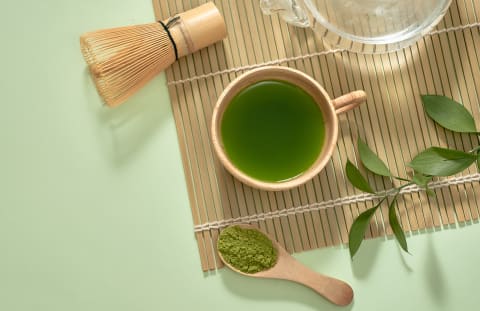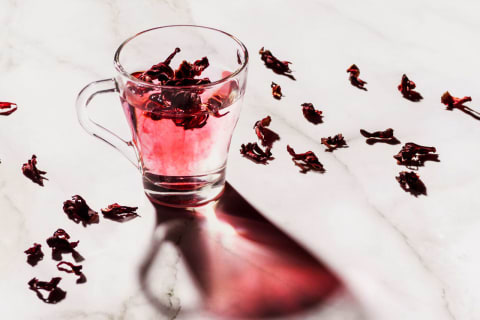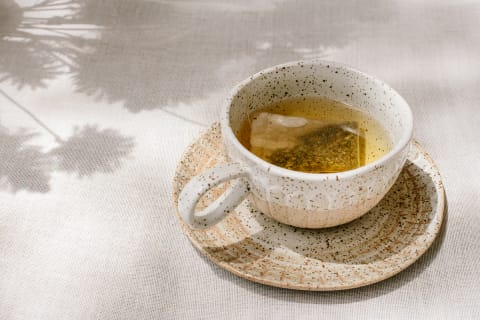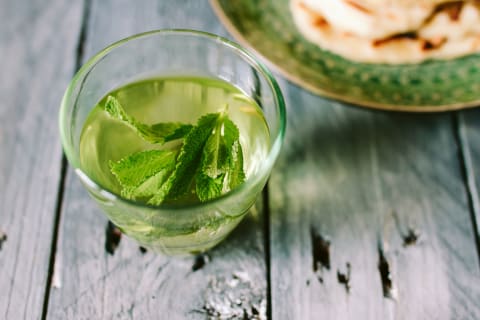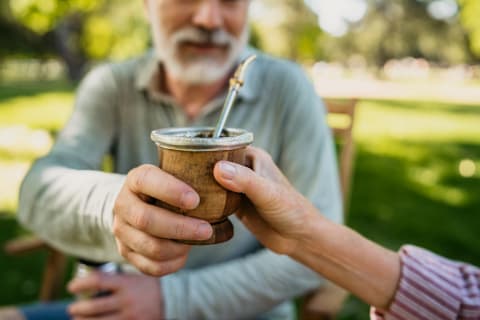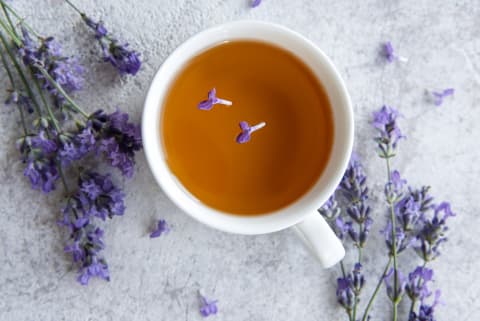Advertisement
6 Healthy Teas For Every Need & How To Drink More Of Them

Teas have been used for thousands of years for health and spiritual purposes (and for pure enjoyment). Sipping on a cup of tea is a peaceful way to hydrate and flood your body with beneficial nutrients and plant compounds.
But, with so many teas to choose from, it can be difficult to narrow it down to those that are the absolute best for your health. While it varies from person to person, this article covers six of the healthiest teas you can sip and explains why they all deserve a spot in your beverage line-up.
The healthiest teas to drink
Generally, tea is broken into six categories1; White, green, yellow, oolong, black, and dark teas. These teas, known as “true” teas, are made from the leaves of Camellia sinensis, a plant native to Southeast Asia.
Herbal teas, like hibiscus tea and chamomile tea, aren’t considered true teas because they’re infusions made from herbs, spices, fruits, flowers, and other plants, not Camellia sinensis. Both herbal teas and true teas contain a variety of beneficial plant compounds that are known to promote overall health.
Some teas have been shown to be especially helpful for certain ailments and health conditions, such as digestive issues and anxiety, while others are used to induce sleep or boost energy levels.
No matter what aspect of health you’re trying to improve, there’s a tea out there for you. Here are six of the healthiest teas you can sip.
Best for overall health: Green tea
The major flavonols found in green tea include quercetin, kaempferol, myricetin, chlorogenic acid, coumaroylquinic acid, and theogallin, all of which can help protect against cellular damage2 that may otherwise lead to increased disease risk. The most well-known antioxidant concentrated in green tea is the catechin epigallocatechin gallate (EGCG). ECGC protects health in several ways and has been shown to provide antidiabetic, anticancer, neuroprotective, and anti-inflammatory2 effects.
People who regularly consume green tea have a lower risk of common health conditions, such as type 2 diabetes3, heart disease4, and certain cancers5. What’s more, studies show that diets rich in green tea may help protect against obesity and promote fat loss6.
Drinking green tea may also help you maintain healthy blood pressure levels7, promote healthy aging8 and longevity, and improve certain aspects of mental health. A 2022 review and meta-analysis published in The Journal of Nutritional Science and Vitaminology that included eight studies found that frequent green tea consumption was associated with 34% reduced risk of depressive symptoms. 9
Summary
How to prepare it:
Green tea has a grassy, slightly sweet taste and is delicious when sipped with a squeeze of lemon.
Matcha, a concentrated green tea powder, can be used to make lattes, frappuccinos, and even smoothies. Both regular green tea and matcha can be enjoyed hot or cold, and can be mixed with ingredients like nut milk and honey to make tasty and eye-catching drinks.
Caffeine:
A cup of brewed green tea10 contains 29.4 milligrams of caffeine, so it’s appropriate for people who can’t handle high doses of this natural stimulant.
However, people who are sensitive to caffeine may want to choose brewed green tea over matcha, as matcha has a relatively high caffeine content. A cup of match can contain between 38 to 178 milligrams11, depending on the amount of matcha used. For comparison12, a cup of brewed coffee contains around 96 milligrams of caffeine.
Because of its caffeine content, green tea is best sipped in the morning and during the day.
Best for beauty: Hibiscus tea
If you’re looking for a tea that will help nourish your skin and act as an internal beauty boost, then hibiscus tea is for you.
Hibiscus tea is made from leafy structures called calyxes found on the Hibiscus Sabdariffa13 plant. It has a deep, ruby color and a tart, fruity taste and is high in plant pigments called anthocyanins14, which are responsible for the tea’s saturated color.
The plant compounds concentrated in hibiscus tea make it an excellent choice for promoting skin health, especially for those with inflammatory skin disorders like acne. In fact, studies show that hibiscus drinks can help reduce inflammatory markers in the body, which may help soothe inflamed skin.
A 2019 study published in Nutrients that included 25 men found that the participants who consumed 250 milliliters of a hibiscus extract drink per day experienced significantly reduced levels of the inflammatory marker16 C-reactive protein ultra-sensitive (CRP-US) compared to drinking plain water. CRP has been shown to be elevated15 in people with dermatological conditions like psoriasis, acne, and rosacea.
In addition to reducing inflammation, the plant compounds found in hibiscus tea can also help protect against oxidative damage, which may help slow the general effects of aging and protect you from skin-related conditions17 like skin cancer.
Plus, hibiscus tea is delicious iced and can be very hydrating. "Since it’s a calorie-free and caffeine-free option, sipping on this tea can provide much-needed fluids, especially since many people are chronically dehydrated,” Lauren Manaker MS, RDN, LD, previously told mindbodygreen.
Keep in mind that while hibiscus tea is generally safe and not linked to many adverse side effects, drinking hibiscus tea isn’t recommended during pregnancy or breastfeeding as it could stimulate menstruation and harm breastfeeding babies.
Summary
How to prepare it:
If you’re bored with plain water, try sipping on hot or iced hibiscus tea for a refreshing way to keep your skin plump and moisturized. You can even grow your own hibiscus flowers at home for a garden-fresh tea. Hibiscus tea can be enjoyed with a bit of honey and a squeeze of lemon, but it’s delish on its own without any additives, too.
You can also add this colorful drink to a nutrient-dense smoothie. Dana Cohen, M.D., an integrative medicine practitioner and co-author of Quench, loves adding hibiscus tea to her hydrating water-cucumber splash smoothie. Here’s how to make it:
Water-cucumber splash smoothie
Ingredients:
- 1 cup cubed watermelon
- 1 medium cucumber peeled, if not organic
- Squeeze of fresh lime juice
- Pinch of coarse sea salt
- 1 or 2 cups of hibiscus or peppermint tea diluted to your preference
- Mint sprig, optional
Method:
- Place all of the ingredients in a blender and secure the lid.
- Blend for 30-35 seconds or until desired consistency is reached.
- Serve immediately.
Caffeine:
Hibiscus tea is caffeine-free, so it’s safe for people who can’t tolerate caffeine or have to avoid it for medical reasons.
Best for sleep: Chamomile tea
Many people struggle to find a natural and safe way to promote restful sleep. If you have a hard time falling or staying asleep, sipping chamomile tea before bed may help you catch some much-needed Zzzs.
Chamomile is a medicinal herb that’s been used since ancient times to treat sleep and anxiety disorders. It’s thought that its sleep-enhancing effects are due to its high concentration of a flavonoid compound called apigenin.
Apigenin binds to benzodiazepine receptors18 in the brain, which produces a calming effect and encourages sleepiness. Studies show that taking chamomile supplements and drinking chamomile tea may help improve sleep quality19 in certain people.
For example, a 2016 study that included 80 postpartum women with poor sleep quality found that the participants who drank chamomile tea for two weeks reported significant improvements in sleep quality20 and reduced depressive symptoms compared to a control group.
A 2011 study published in BMC Complementary Medicine and Therapy that included 34 people with insomnia demonstrated that treatment with 270 milligrams of chamomile extract twice daily for 28 days decreased the time it took to fall asleep21 by approximately 16 minutes and decreased the number of nighttime awakenings compared to a control group.
Summary
How to prepare it:
Chamomile tea has a unique taste that’s “herbaceous and vegetal, warm, mildly floral, a bit savory, and very pleasant," Rachelle Robinett, R.H. (AHG), a registered herbalist previously told mindbodygreen. It's usually consumed hot. If you're drinking chamomile tea before bed, avoid adding honey or extra sugars that could disrupt your slumber.
Caffeine:
Chamomile tea is caffeine-free, so it’s a perfect drink to enjoy while you’re winding down at night.
Best for digestion: Peppermint tea
Peppermint tea is one of the best beverages for people who frequently experience digestive issues like bloating, nausea, stomach pain, and gas (though other teas may be better for constipation).
Peppermint (Mentha piperita) has medicinal properties that can help soothe common tummy troubles associated with conditions like irritable bowel syndrome (IBS). Its oils have soothing, antispasmodic properties, which can help you feel better when you’re experiencing digestive discomfort.
The oils found in peppermint contain L-menthol, a monoterpenoid compound that blocks calcium channels in smooth muscle, which helps reduce spasms in the gastrointestinal tract. Peppermint oil also offers anti-inflammatory and pain-relieving effects22, which may benefit those with digestive conditions like IBS
A 2019 review published in BMC Complementary Medicine and Therapies that included 12 studies found that treatment with peppermint oil significantly reduced pain and improved symptoms in people with IBS23.
Summary
How to prepare it:
Peppermint tea can be made with fresh or dried peppermint leaves. Steeping the leaves in hot water releases their beneficial oils and a pleasing aroma. Studies also show that simply smelling peppermint oil can help soothe nausea,24 making peppermint tea a smart choice when you’re sick with a stomach bug.
Caffeine:
Peppermint tea is naturally caffeine-free, so it can be sipped any time, including before bed.
Best for energy: Yerba mate
Yerba maté tea is made from the leaves of the yerba maté tree, which is native to South America. The traditional drink is commonly consumed in countries like Argentina, Brazil, and Chile, but it’s less popular in the US.
Yerba maté tea contains about 80 milligrams of caffeine per cup25, which is comparable to the caffeine found in a cup of coffee. Because it contains a good amount of caffeine, it can give you the boost of energy you need to start your day or power through your mid-day slump at work.
The caffeine found in yerba maté stimulates an area of the brain called the cerebral cortex25, which can help boost energy and improve concentration, reaction time, and alertness.
In addition to caffeine, yerba maté provides a variety of plant compounds26, including phenolic acids, flavonoids, and terpenes, which offer antioxidant and anti-inflammatory benefits. Plus, it provides some nutrients, like magnesium, zinc, copper, iron, and manganese.
Summary
How to prepare it:
Yerba maté is traditionally consumed in a vessel called a mate cup using a metal straw with a filter known as a bombilla. However, you can brew yerba maté at home using any tea pot, tea strainer, or French press.
Yerba maté can be enjoyed plain or with a bit of sweetener. It has a strong, earthy, slightly bitter taste that takes some getting used to, so you may want to lightly steep your yerba maté tea until you get used to its flavor.
Caffeine:
Yerba maté tea contains about 80 milligrams of caffeine per cup25, about the same as a cup of coffee.
Best for relaxation & mood: Lavender tea
Lavender products, like lavender essential oil and lavender bath soaks, are well-known for their relaxing and stress-reducing properties.
Consuming lavender can also have positive effects on the body and is particularly helpful for improving certain aspects of mental health.
Lavender tea is made by steeping fresh or dried lavender flower buds in hot water. It has a floral, slightly sweet taste and an aroma that can help you feel more relaxed. In fact, studies show that smelling lavender, including diffusing lavender essential oil, can help decrease anxiety and lift mood27.
“The aroma of lavender relaxes the nervous system and produces a calming and soothing effect on the body," Kami McBride, an herbal educator and author of The Herbal Kitchen, previously told mindbodygreen.
Drinking lavender tea has been shown to help decrease feelings of anxiety and depression, so it can be a helpful option when you need an easy way to calm your mind. A 2020 study that included 60 older adults found that drinking lavender tea twice a day for two weeks reduced depression and anxiety28 scores compared to a control group.
Consuming and smelling lavender has also been shown to improve fatigue29, boost mood, and encourage restful sleep30.
Summary
How to prepare it:
Lavender tea can be found in loose-leaf form and can also be purchased in single-use teabags. It’s delicious on its own, but can be enjoyed with additives like lemon and honey.
When you’re feeling stressed, try brewing a hot cup of lavender tea and sipping it in a quiet, peaceful environment to help your body and mind wind down.
Caffeine:
Lavender tea is naturally caffeine-free, so it can be sipped any time, including before bed.
When to drink tea
Decaffeinated tea, like hibiscus or peppermint tea, can be enjoyed at any time of day or night. Though people who aren’t as sensitive to caffeine can drink caffeinated tea later in the day, sipping caffeinated tea, like green tea or yerba maté, in the afternoon or at night might negatively impact sleep in people who are sensitive to caffeine’s stimulatory effects. In fact, some research shows that drinking caffeinated beverages within six hours31 of bedtime can make it harder to fall and stay asleep.
Incorporating tea into your life
Drinking unsweetened tea can be a healthy and delicious way to stay hydrated while supplying your body with a source of protective plant compounds, like polyphenol antioxidants.
Though hot tea is most popular, tea can be enjoyed in other ways, too. “Tea can be enjoyed in hot water infusions, iced, or mixed into smoothies,” says Cohen. Cohen uses herbal teas like peppermint and hibiscus tea to add flavor and nutritional benefits to smoothies and other cold drinks.
Here are a few more ways to incorporate tea into your life:
- Swap your morning coffee for a cup of green tea or herbal tea. If you’d like a caffeinated beverage in the morning, choose brewed green tea, matcha, or a cup of yerba maté.
- Add tea into your nightly ritual by enjoying a cup of herbal, decaffeinated tea while you wind down and get ready for bed. Some teas, like chamomile tea, have sleep-enhancing properties and may help you get a better night’s rest.
- Make tea ice cubes and use them to make iced tea and tea-based smoothies. Brew some peppermint, chamomile, or hibiscus tea then freeze the tea in ice trays. You can use tea ice cubes to cool down and add flavor to a number of beverages.
- Sip on a cup of caffeinated tea before your workout. Drinking a caffeinated beverage, like green tea or matcha, before a workout can help you feel more energized and improve exercise performance32.
- Brew a cup of peppermint tea when you’re under the weather. When you’re sick, sipping on a cup of peppermint tea can help keep you hydrated. Plus, peppermint tea may help soothe digestive symptoms like nausea and stomach pain.
Frequently Asked Questions
What is the unhealthiest tea?
All teas are healthy when they’re consumed plain. However, adding high-sugar ingredients to your tea, like flavored creamer or table sugar, changes the nutritional benefits of the beverage.
When possible, it’s best to consume your tea plain or opt for low-sugar ingredients like lemon juice or a dash of cinnamon. If using a sweetener, like honey, stick with a small amount, such as a teaspoon.
What is the healthiest tea without caffeine?
There are a variety of healthy decaf teas to choose from, including hibiscus tea, peppermint tea, and chamomile tea.
Which tea has the most antioxidants?
Green tea is one of the best choices for overall health because it's a concentrated source of protective plant compounds, such as polyphenol antioxidants.
The takeaway
Though many teas offer health benefits, the teas listed above stand out from the crowd. Green tea, hibiscus tea, chamomile tea, peppermint tea, yerba maté, and lavender tea are packed with plant compounds that can promote overall health, improve energy, enhance sleep, and more.
If you’re looking for other ways to hydrate in a healthy way, check out more healthy drinks to sip on, from kombucha to alkaline water.
32 Sources
- https://www.ncbi.nlm.nih.gov/pmc/articles/PMC6941079
- https://www.ncbi.nlm.nih.gov/pmc/articles/PMC6412948/
- https://www.ncbi.nlm.nih.gov/pmc/articles/PMC8246622/
- https://www.ncbi.nlm.nih.gov/pmc/articles/PMC9729734/
- https://www.ncbi.nlm.nih.gov/pmc/articles/PMC9658101/
- https://pubmed.ncbi.nlm.nih.gov/33207344/
- https://pubmed.ncbi.nlm.nih.gov/32507441/
- https://www.ncbi.nlm.nih.gov/pmc/articles/PMC6571865/
- https://pubmed.ncbi.nlm.nih.gov/35768246/
- https://fdc.nal.usda.gov/fdc-app.html#/food-details/171917/nutrients
- https://www.ncbi.nlm.nih.gov/pmc/articles/PMC7796401/
- https://fdc.nal.usda.gov/fdc-app.html#/
- https://www.ncbi.nlm.nih.gov/pmc/articles/PMC9033014/
- https://www.ncbi.nlm.nih.gov/pmc/articles/PMC6100195/
- https://www.ncbi.nlm.nih.gov/pmc/articles/PMC8444194/
- https://www.ncbi.nlm.nih.gov/pmc/articles/PMC6412462/
- https://pubmed.ncbi.nlm.nih.gov/32344257/
- https://www.ncbi.nlm.nih.gov/pmc/articles/PMC9611340/
- https://pubmed.ncbi.nlm.nih.gov/31006899/
- https://pubmed.ncbi.nlm.nih.gov/26483209/
- https://www.ncbi.nlm.nih.gov/pmc/articles/PMC3198755
- https://www.ncbi.nlm.nih.gov/pmc/articles/PMC5814329/
- https://www.ncbi.nlm.nih.gov/pmc/articles/PMC6337770/
- https://pubmed.ncbi.nlm.nih.gov/32985338/
- https://www.ncbi.nlm.nih.gov/pmc/articles/PMC8622869/
- https://www.ncbi.nlm.nih.gov/pmc/articles/PMC8622869/'
- https://www.ncbi.nlm.nih.gov/pmc/articles/PMC3612440
- https://pubmed.ncbi.nlm.nih.gov/32444033/
- https://pubmed.ncbi.nlm.nih.gov/26523950/
- https://www.ncbi.nlm.nih.gov/pmc/articles/PMC6718645/
- https://www.ncbi.nlm.nih.gov/pmc/articles/PMC3805807/
- https://www.ncbi.nlm.nih.gov/pmc/articles/PMC7777221/
Watch Next
Enjoy some of our favorite clips from classes
Enjoy some of our favorite clips from classes
What Is Meditation?
Mindfulness/Spirituality | Light Watkins
Box Breathing
Mindfulness/Spirituality | Gwen Dittmar
What Breathwork Can Address
Mindfulness/Spirituality | Gwen Dittmar
The 8 Limbs of Yoga - What is Asana?
Yoga | Caley Alyssa
Two Standing Postures to Open Up Tight Hips
Yoga | Caley Alyssa
How Plants Can Optimize Athletic Performance
Nutrition | Rich Roll
What to Eat Before a Workout
Nutrition | Rich Roll
How Ayurveda Helps Us Navigate Modern Life
Nutrition | Sahara Rose
Messages About Love & Relationships
Love & Relationships | Esther Perel
Love Languages
Love & Relationships | Esther Perel
